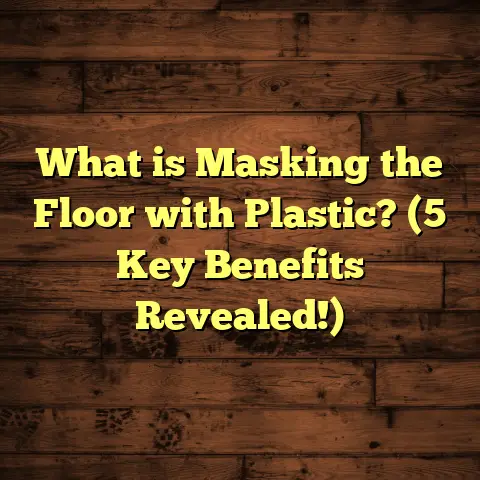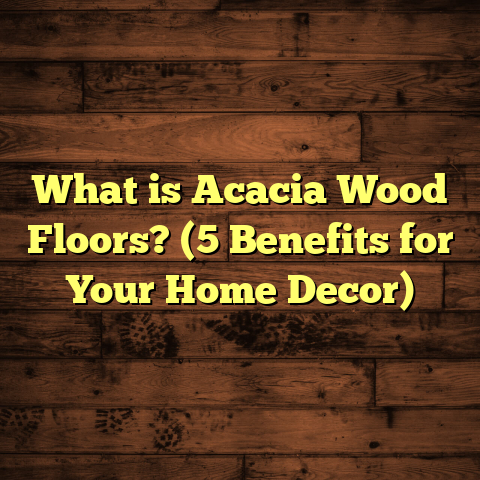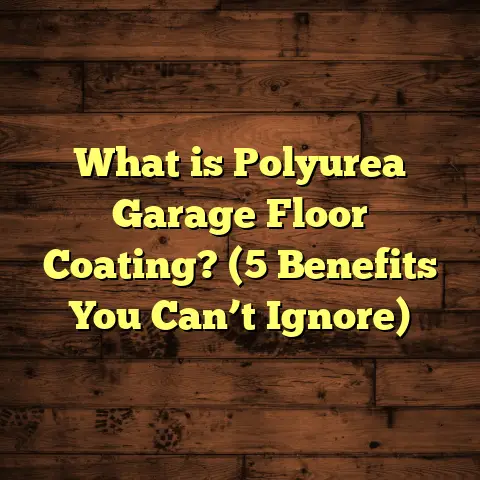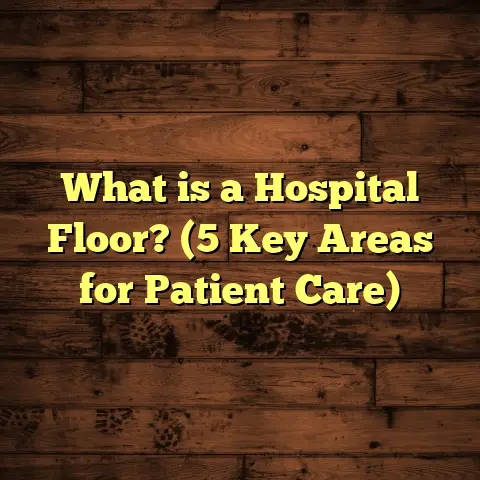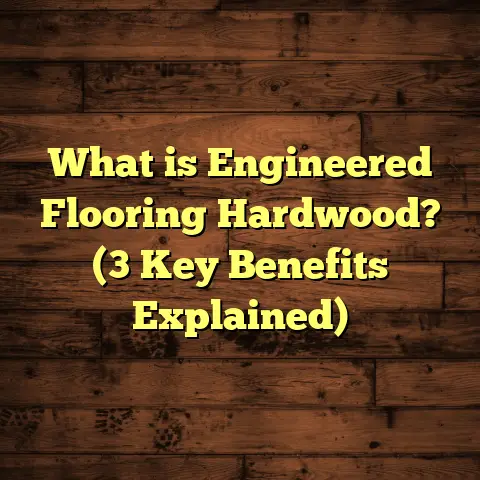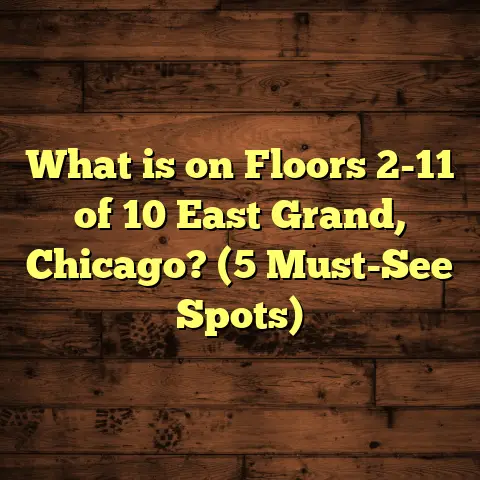What is a Vapor Barrier for Flooring? (5 Key Benefits & Tips)
I still remember watching those classic sci-fi movies where mysterious fog would creep under doors and swirl across shiny, futuristic floors. You’d think the set designers had a secret weapon for keeping moisture out of those pristine spaces. Well, in the world of real-life flooring, that secret weapon is something called a vapor barrier. It isn’t flashy or dramatic like a movie fog, but it quietly plays a huge role in protecting your floors and home from moisture damage.
What Is a Vapor Barrier for Flooring?
A vapor barrier, simply put, is a material that stops moisture from passing through the floor structure. It’s usually a thin sheet made of plastic or foil that sits between the concrete slab or subfloor and the flooring material you walk on. Its main job is to block water vapor rising from the ground or concrete slab below from reaching your flooring.
Why does this matter? Well, moisture can cause all sorts of problems in floors. Think warping hardwood, swollen laminates, mold growth, and even structural damage over time. The vapor barrier acts as a shield, preventing that invisible moisture from sneaking upward and wrecking your floors.
I’ve installed hundreds of floors over the years, and I’ve seen firsthand what happens when a vapor barrier is missing or poorly installed. Some jobs looked beautiful at first but began showing signs of moisture damage within months. Trust me—taking the time to add a proper vapor barrier pays off big in the long run.
How Does a Vapor Barrier Work?
Moisture travels through concrete slabs and soil beneath homes as water vapor—not always as liquid water. Vapor barriers work by creating an impermeable layer that stops these microscopic water molecules from migrating upward.
Most vapor barriers have a perm rating—a measure of how much moisture can pass through per unit area over time. The lower the perm rating, the better the barrier blocks vapor. For flooring applications, you want something with a perm rating below 0.1, which is considered a true vapor barrier according to industry standards.
If you’re curious about perm ratings, here’s a quick breakdown:
- Vapor Retarder: Perm rating between 0.1 and 1.0 (slows moisture but doesn’t stop it completely)
- Vapor Barrier: Perm rating below 0.1 (blocks nearly all moisture)
Choosing the right material is vital because not all “barriers” are created equal. Some are just retarders, which may not fully protect your floors in high-moisture environments.
Different Types of Vapor Barriers
There are several common types of vapor barriers used in flooring projects:
- Polyethylene Sheeting: The most common and affordable option, usually 6 mil or thicker plastic sheets. Easy to install and effective when properly sealed.
- Foil-Faced Membranes: Plastic sheets laminated with reflective foil layers. These add radiant heat reflection to moisture blocking but cost more.
- Rubberized Coatings: Liquid-applied membranes that cure into a seamless barrier. Great for complex shapes but require professional application.
- Peel-and-Stick Membranes: Self-adhesive sheets that stick directly to concrete slabs for a secure seal.
I’ve worked mostly with polyethylene sheeting because it’s straightforward and reliable for typical residential projects, but for commercial or specialty installations, other types might be better suited.
5 Key Benefits of Using a Vapor Barrier for Flooring
I can’t stress enough how much difference this simple layer makes once you understand its benefits fully. Let me break down the five biggest advantages I’ve seen firsthand.
1. Protects Against Mold and Mildew Growth
One of the biggest headaches I’ve dealt with on job sites is mold growing beneath floors. Moisture trapped under flooring creates an ideal environment for mold spores to thrive, which can cause unpleasant odors and health issues.
Mold spores are everywhere in the air around us, but they need moisture to grow into visible colonies that cause problems. When floors don’t have proper vapor protection, water vapor rises through slabs and saturates materials like wood or carpet padding beneath your floor covering.
Studies show that homes with effective vapor barriers under flooring have 60% less reported mold problems compared to those without. In fact, according to the Environmental Protection Agency (EPA), mold growth indoors is strongly linked to moisture intrusion in building materials.
A few years ago on a condo project I supervised, the absence of a vapor barrier led to persistent mold issues beneath carpeted floors in several units. We had to remove and replace flooring multiple times before installing proper vapor barriers stopped recurring growth.
If you or someone you know has ever experienced that musty basement smell or noticed black spots on wood floors near concrete slabs, chances are poor moisture control was the culprit.
2. Prevents Flooring Warping and Buckling
Have you ever seen hardwood floors cup or laminate floors swell after installation? That’s usually due to moisture seeping up from below.
When moisture gets trapped under wood-based floors, it causes the wood fibers to expand unevenly, leading to warps, gaps, and buckles. Vapor barriers maintain stable moisture levels beneath your floors, protecting their integrity.
In one project I managed, skipping the vapor barrier on a hardwood install led to boards lifting within weeks. After fixing it with a proper barrier and ventilation, the floors stayed perfectly flat for years.
Wood’s response to moisture is well-documented: it expands when wet and contracts when dry. This constant movement wreaks havoc on floorboards if unchecked. According to the Hardwood Manufacturers Association (HMA), flooring installed without adequate moisture protection can have up to a 30% higher risk of dimensional changes.
Laminate flooring is also vulnerable; its core layers swell dramatically when exposed to moisture vapor from below. Vinyl flooring can sometimes peel because adhesives lose strength when damp.
Vapor barriers stabilize moisture levels under all these materials by blocking vapor migration from slabs or crawlspaces below.
3. Enhances Energy Efficiency
A vapor barrier also helps with energy savings in ways many people don’t realize.
Moisture passing through floors can carry heat away or cause condensation that chills cold floors during winter months. This leads to uncomfortable cold spots and forces your heating system to work harder.
By blocking moisture movement, vapor barriers reduce heat loss through floors and improve insulation performance. According to research by building scientists at Oak Ridge National Laboratory, homes with well-installed vapor barriers can save up to 10% on heating costs annually.
Even beyond heating bills, controlling moisture with vapor barriers helps maintain indoor air quality by preventing dampness that encourages dust mites and allergens.
In one winter renovation I did on an older home with a concrete slab foundation, after installing a vapor barrier under new hardwood floors plus additional insulation layers, the homeowners noticed their feet stayed warm without raising their thermostat settings.
4. Increases Flooring Lifespan
I once worked on a commercial project where vinyl tiles were installed over concrete without any moisture protection. Within two years, many tiles lifted and cracked due to trapped moisture damage.
Using a vapor barrier extends flooring lifespan by protecting adhesives and materials from moisture breakdown. Flooring manufacturers often require vapor barriers to maintain product warranties because they know how critical moisture control is.
Research from the Tile Council of North America (TCNA) shows that floor failures related to adhesive deterioration drop dramatically when proper vapor barriers are installed beneath tile systems on slabs.
The same principle applies across many floor types: wood glue joints stay strong longer; laminate cores resist swelling; vinyl adhesives bond better—all because they stay dry beneath their surface.
From my experience, adding vapor barriers can extend typical hardwood or laminate flooring lifespans by anywhere from 5 to 15 years depending on local climate conditions.
5. Minimizes Structural Damage
Water damage isn’t limited to just your floor surface; it can affect the subfloor and structural framing below too.
Excessive moisture causes wood rot, corrosion of metal fasteners, and deterioration of concrete slabs over time. I’ve seen homes with serious foundation issues caused by unchecked moisture migration through floors.
In one older home I inspected before renovation, widespread subfloor mold and wood rot were traced back to missing vapor barriers combined with poor crawlspace ventilation.
Vapor barriers act as an early defense line against these costly structural problems by controlling moisture at the source.
The National Association of Home Builders (NAHB) estimates that moisture-related structural repairs account for nearly 20% of all home repair costs annually—costs that could be reduced significantly by proper vapor barrier installation during initial construction or remodeling.
Detailed Tips for Installing Vapor Barriers Successfully
Knowing why vapor barriers matter is one thing—actually installing them correctly is another challenge altogether. Let me share some practical tips based on years of hands-on experience that will help you avoid common pitfalls.
Choose the Right Material
Not all vapor barriers are created equal. Popular materials include polyethylene plastic sheeting (6 mil or thicker), foil-faced membranes, and specialized rubberized coatings.
I recommend using at least 6 mil polyethylene because thinner sheets tear easily during installation. Foil-faced options add some radiant heat reflection benefits but cost more upfront.
For crawlspaces or slabs with high moisture levels, thicker 10 mil sheets provide extra protection at marginal extra cost.
If you’re working on a commercial project or specialized installation like radiant heating floors embedded in slabs, consider peel-and-stick membranes or liquid-applied coatings for best performance.
Cover the Entire Area Without Gaps
One of the biggest mistakes I see is leaving seams loosely joined or failing to tape them properly. Seams must overlap by at least 6 inches and be sealed with waterproof tape to prevent vapor leaks.
Don’t forget to extend the barrier up walls or around pipes where moisture can sneak through gaps.
In one job I did for a school gym floor replacement, poor seam sealing led to localized mold growth beneath vinyl tiles months after installation—something easily avoided with thorough taping.
Install Before Flooring and After Subfloor Prep
Lay your vapor barrier right on top of the concrete slab or subfloor after it’s clean and dry but before installing underlayment or finish flooring.
Avoid walking heavily on the barrier during installation to prevent punctures. Use plywood sheets temporarily if needed for moving tools around before final floor installation.
Account for Waste Factor
Cutting sheets and overlapping seams means you need extra material. On average, plan for 5-10% waste when ordering vapor barrier material.
I always order a little more than calculated because tears happen during handling or unexpected layout changes arise once work starts onsite.
Consider Climate and Local Building Codes
In humid climates or areas with high groundwater levels, vapor barriers are an absolute must.
Some local codes require vapor barriers under certain flooring types—check before you start.
For instance, in coastal regions or basements prone to flooding, codes often specify thicker sheets or additional protective layers like drainage mats beneath slabs alongside vapor barriers.
Deeper Look: Vapor Barriers and Different Flooring Types
Understanding how vapor barriers interact with various flooring materials helps tailor installation strategies for best results.
Hardwood Floors
Hardwood is sensitive to moisture changes because its wood fibers absorb water causing expansion or contraction.
Installing a vapor barrier underneath hardwood prevents moisture from causing cupping (edges higher than center) or crowning (center higher than edges).
Make sure your hardwood has acclimated to local humidity before installation too—vapor barrier isn’t magic but part of an overall moisture management strategy including proper acclimation and indoor humidity control (ideally between 35-55%).
Laminate Floors
Laminate’s core swells quickly if exposed to water vapor, leading to bubbling or buckling joints.
Since laminates are typically floating floors (not glued), even small amounts of trapped moisture can cause long-term damage underneath planks.
A robust vapor barrier combined with good underlayment designed for moisture resistance makes all the difference here.
Vinyl Flooring
Vinyl itself is waterproof but relies heavily on adhesives for installation durability which break down when wet beneath slabs without barriers.
This can cause tiles or planks lifting over time especially in basements or ground-level rooms with high slab moisture content.
Using a quality vapor barrier protects adhesives while also preventing mold growth under vinyl layers including luxury vinyl tile (LVT).
Ceramic or Porcelain Tiles
Tile is water-resistant but grout lines and thinset mortar can absorb moisture if no barrier exists underneath porous concrete slabs.
Vapor barriers reduce chances of efflorescence (white salt deposits) appearing on grout surfaces caused by water migrating through slabs carrying dissolved salts upward.
Tile manufacturers often require vapor barriers when tiling direct-to-slab surfaces per TCNA guidelines for warranty protection reasons too.
My Experience Using FloorTally for Project Cost Estimation
When I’m planning flooring projects involving vapor barriers, I use an online tool called FloorTally to get accurate cost estimates quickly. It factors in local labor rates, material costs—including vapor barrier sheets—and waste allowance.
This saves me hours compared to calling multiple suppliers for quotes or guessing quantities. Plus, it helps me create realistic budgets my clients appreciate because everything is broken down clearly.
For example, when pricing out a large vinyl floor install over concrete slab with a vapor barrier in Chicago, FloorTally showed me total costs including materials and labor within minutes. This made negotiating with clients much easier since I had solid numbers backing my proposal.
In another case involving hardwood installed over new slab in Denver’s dry climate, FloorTally helped me compare costs between different barrier materials plus labor time estimates—resulting in optimized budget without compromising quality standards.
If you’re wondering what goes into those cost estimates: FloorTally includes quantities based on room dimensions plus waste factor (usually 5-10%), local prices for polyethylene sheeting or specialty membranes where applicable, labor hours estimated from past projects adjusted for regional wage differences, plus other items like tape/sealants needed for seams—all in one place so nothing gets missed during planning phases.
Case Study: Vapor Barrier Impact on Hardwood Flooring Durability
A homeowner in Minnesota hired me to install hardwood flooring over a concrete slab in her basement. Initially, she thought a vapor barrier wasn’t necessary because the basement seemed dry most of the year except during wet springs.
I insisted on installing a 10 mil polyethylene vapor barrier anyway due to local humidity levels and slab conditions monitored by sensors I placed beforehand.
Two years later, she called me back to say her floors were still flawless—no warping or mold issues despite several wet seasons outside including below-freezing winters causing condensation concerns inside basement space.
Her neighbor had installed similar hardwood without a vapor barrier and was already facing cupping boards and musty smells after one rainy season.
This case clearly showed how much difference a proper vapor barrier makes even when conditions appear dry superficially but underlying slab moisture fluctuates seasonally causing hidden risks beneath floors over time.
Common Misconceptions About Vapor Barriers
People often misunderstand what vapor barriers do or confuse them with other building materials like waterproofing membranes or air barriers. Here are some common myths:
- Myth: Vapor barriers stop liquid water leaks completely
Reality: They mainly block water vapor. For actual water leaks like flooding you need waterproof membranes or drainage systems alongside good site grading outdoors. - Myth: Vapor barriers cause trapping of moisture leading to mold
Reality: Properly installed barriers prevent moisture ingress from below; poorly installed ones with gaps might trap existing surface dampness causing issues. - Myth: All plastic sheets qualify as good vapor barriers
Reality: Thickness & perm rating matter—some thin plastics act only as retarders allowing some moisture through which isn’t enough protection in many cases. - Myth: Vapor barrier installation increases project cost too much
Reality: Costs are generally modest compared to potential damage repair expenses avoided long-term; tools like FloorTally help estimate costs accurately reducing surprises.
Understanding these facts helps homeowners make better decisions rather than skipping vital steps based on misunderstandings or misinformation spread online or through word-of-mouth rumors in construction circles.
How Moisture Moves Through Floors: A Closer Look at Physics
Understanding why we need vapor barriers means understanding how water moves through building materials:
- Water exists as liquid (like puddles) and as invisible gas/vapor.
- Concrete slabs absorb ground moisture like a sponge.
- Heat differences cause water molecules to move upwards as vapor through porous materials.
- This movement happens even if you don’t see wetness on top surfaces.
- Without barriers stopping this migration, moisture accumulates beneath flooring causing damage unseen until problems become obvious.
Building scientists call this process “vapor drive” — water moving from wetter areas (soil below slab) toward drier indoor air above floor surface driven by temperature gradients in winter especially.
The solution? Install something impermeable right at slab surface like polyethylene sheets creating resistance against water molecule movement upward protecting your finished floors above indefinitely if maintained well during installation phase with sealed joints/taped seams etc.
Practical Advice: Questions You Should Ask Before Installing Vapor Barriers
Thinking about adding a vapor barrier? Here are some questions I ask myself—and my clients—to ensure we get it right:
- What type of subfloor am I covering? Concrete slab? Crawlspace? Wood joists?
- How much ground moisture typically exists here? Have previous issues occurred?
- What type of finish flooring will go over this? Hardwood? Laminate? Tile? Carpet?
- Are there local code requirements specifying minimum barrier type/thickness?
- What’s my budget? Which material offers best value balancing cost & performance?
- Do I have proper tools/materials for seam sealing & taping?
- Will I coordinate ventilation improvements alongside barrier installation?
Answering these helps avoid surprises later like discovering slab dampness after expensive finish floor installed without protection—something I’ve unfortunately witnessed too many times early in my career before learning these lessons well myself!
Maintenance Tips After Installing Vapor Barriers
Installing your barrier properly isn’t just set-it-and-forget-it work:
- Avoid puncturing sheets during subsequent trades working onsite.
- Inspect seams periodically if accessible during renovations.
- Control indoor humidity levels using dehumidifiers especially in basements/crawlspaces.
- Fix plumbing leaks promptly so water doesn’t accumulate under floors.
- Ensure crawlspaces have adequate ventilation reducing overall ground moisture load.
Taking these steps extends life expectancy of your flooring system dramatically saving money down road avoiding costly repairs/replacements due to hidden moisture damage underfoot nobody sees until too late!
Summary: Why Vapor Barriers Matter More Than You Think
From my years installing floors across varied climates and building types:
- Vapor barriers stop invisible water molecules damaging your investment silently.
- They prevent costly mold growth impacting health & property value.
- They keep wood & laminate planks flat & stable.
- They help reduce heating bills by blocking moist air flow through floors.
- They protect structural elements underneath from rot & corrosion risk.
Adding this simple layer during your next floor installation project isn’t just smart—it’s almost mandatory if you want durable beautiful floors lasting decades not just years before needing replacement prematurely due to preventable moisture problems!
If you’re tackling new construction or renovating existing floors over concrete slabs or crawlspaces anytime soon—I’m happy to share more tips specific to your project details just ask! Whether it’s deciding material types or installation methods or budgeting with tools like FloorTally—I got your back making sure your floors stand strong against time and moisture alike!
